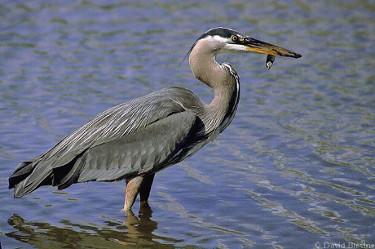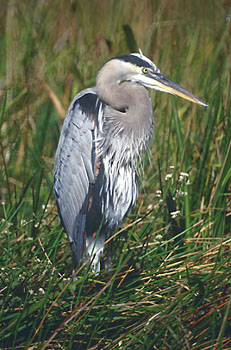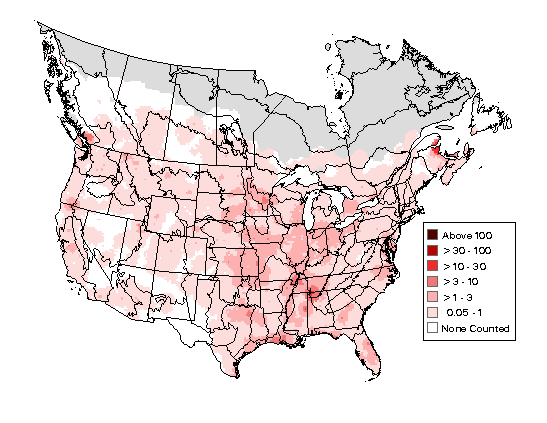Great Blue Heron

Great Blue Heron Information
Length: 38 - 52"
Breeding Habitat: Marshes, swamps, tidal flats, shallow coastal bays; shores of ponds, lakes, and rivers. Prefers habitat that includes tall trees for nesting.
Diet: Mostly fish; also frogs, salamanders, lizards, crayfish, snakes, crustaceans, aquatic and terrestrial insects. Some small birds and small mammals (such as rodents).
Additional Information
Great Blue HeronHabitat, diet, feeding behavior, nesting, migration, and conservation status of this bird. Includes range map, photos, and songs and calls. (From Audubon Field Guide)
Great Blue Heron

Great Blue Heron
Identification Tips
- Sexes similar
- Huge long-legged long-necked wader
- Usually holds neck in an "S" curve at rest and in flight
- Long, thick, yellow bill
- White crown and face
- Black plume extending from above and behind eye to beyond back of head
- Brownish-buff neck with black-bordered white stripe down center of foreneck
- Blue-gray back, wings and belly
- Shaggy neck and back plumes in alternate plumage
- Black cap
- Brownish-gray back and upperwings
- Lacks shaggy neck and back plumes
- Lacks black plume extending from behind eye
(Credit: U. S. Geological Survey)
Breeding Bird Survey Map,
2011-2015

(Image credit: USGS)
Range in New England
The Great Blue Heron can be found throughout the year in New England.
Some Great Blues that breed in this region move further south in the winter and return in the spring. Others remain through the winter, mainly along the coast or where there is open freshwater inland.
Winter Map from eBird
Sightings of the Great Blue Heron from
Dec-Jan over past 10 years
(2009-2019)![]()
Christmas Bird Count Map
Historical CBC Map from USGS